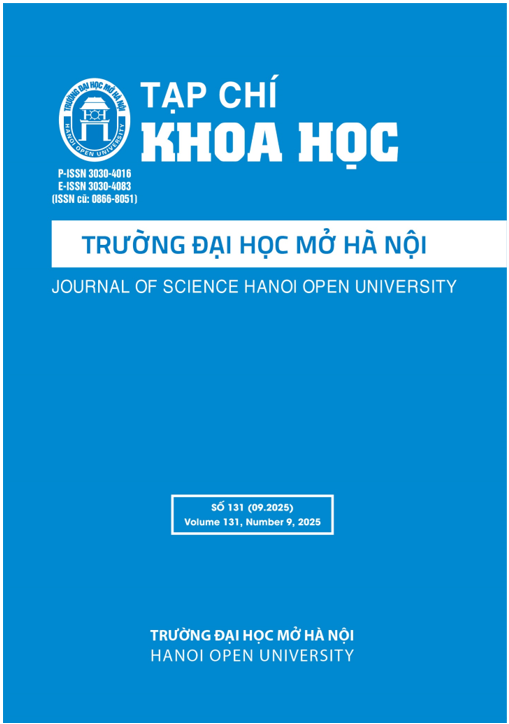WRITING APPREHENSION AND WRITING SKILLS AMONG ENGLISH-MAJOR STUDENTS: A CORRELATION-BASED APPROACH
DOI:
https://doi.org/10.59266/houjs.2025.746Từ khóa:
writing apprehension, writing skills, majoring students, a correlational approachTóm tắt
This study investigated the relationship between students' writing abilities and writing anxiety using two separate instruments: a questionnaire for assessing students' writing anxiety and a writing test using descriptive texts to evaluate students' writing skills. The target population for this study was the English department students of the University of Economics -Technology for Industries (UNETI), and it employed a quantitative correlational research methodology. In order to select a representative sample and represent the population, the researchers also used a correlational approach and cluster sampling. The researchers chose 35 second-year English major students from the second semester to serve as the sample for one class, which they used to conduct the analysis. The researchers found a negative link between students' writing skills and writing anxiety, and they came to the conclusion that r = -0.642 was the association between the two. The more often students worried about writing, the worse their performance was on writing assessments, according to the inverse correlation. It can also be concluded that there is a significant relationship between students' writing proficiency and their level of writing apprehension.
Tài liệu tham khảo
[1]. Alfiansyah, F., Jaufillaili, J., & Hendriwanto, H. (2017). The Analysis of Students’ Anxiety in Learning Writing at the 10th Grade of Vocational High School. Leksika: Jurnal Bahasa, Sastra dan Pengajarannya, 11(2), 12. https://doi.org/10.30595/lks. v11i2.2074.
[2]. Alnufaie, M., & Grenfell, M. (2013). EFL writing apprehension: The macro or the micro? Journal of Arts and Humanities, 2(3), 79-89.
[3]. Arindra, M. Y., & Ardi, P. (2020). The correlation between students’ writing anxiety and the use of writing assessment rubrics. LEARN Journal: Language Education and Acquisition Research Network, 13(1), 76-93.
[4]. Atmowardoyo, H., & Sakkir, G. (2021). The Development of Language Learning Theory Based on Best Practice: A Literature Review. In Proceedings of the Tenth International Conference on Languages and Arts (ICLA 2021) (pp. 172-184). Atlantis Press.
[5]. Badrasawi, K. J. I., Zubairi, A., & Idrus, F. (2016). Exploring the Relationship between Writing Apprehension and Writing Performance: A Qualitative Study. International Education Studies, 9(8), 134. https://doi.org/10.5539/ies.v9n8p134.
[6]. Bloomfield, J., & Fisher, M. J. (2019). Quantitative research design. Journal of the Australasian Rehabilitation Nurses Association, 22(2), 27-30. https:// search. informit. org/ doi/ 10. 3316/ informit.738299924514584.
[7]. Boonyarattanasoontorn, P. O. O. N. Y. A. P. A. T. (2017). An investigation of Thai students’ English language writing difficulties and their use of writing strategies. Journal of Advanced Research in Social Sciences and Humanities, 2(2), 111-118.
[8]. Brown, H. D. (2004). Language Assessment: Principles and Classroom Practices. New York: Longman.
[9]. Brown, H. D. & Abeywickrama, P. (2010). Language assessment: Principles and classroom practices (2nd ed.). Pearson Education.
[10]. Brown, H. D. (2001). Teaching by Principles: An Interactive Approach to Language Pedagogy. New-York: Longman.
[11]. Castillo, M. (2009). English as an International Language: Web- based help. American Journal of Neuroradiology, 30 (5) 857-858; https://doi.org/10.3174/ajnr.A1516.
[12]. Cheng, Y. S. (2004). A measure of second language writing anxiety: Scale development and preliminary validation. Journal of Second Language Writing, 13(4), 313-335.
[13]. Crystal, D. (2003). English as a Global Language (2nd ed.). Cambridge: Cambridge University Press. http://dx.doi.org/10.1017/ CBO9780511486999.
[14]. Daly, J. A., & Wilson, D. A. (1983). Writing apprehension, self-esteem, and personality. Research in the Teaching of English, 17 (4), 327-341.
[15]. Daly, J. A., & Miller, M. D. (1975). The Empirical Development of an Instrument to Measure Writing Apprehension. Research in the Teaching of English, 9 (3), 242-249.
[16]. Daly, J. A. (1985). Writing apprehension. In M. Rose (Ed.), When a writer can’t write: Studies in writer’s block and other composing-process problems (pp. 43-82). Guilford Press.
[17]. David, A. R., Azman, H., & Ming, T. S. (2018). Investigating online dialogue journal writing impacts on low proficiency students’ writing anxiety. International Journal of Language Education and Applied Linguistics, 71-81. https://doi. org/10.15282/ijleal.v8.1051.
[18]. Elif, G. E. N. C., & Yayli, D. (2019). The second language writing anxiety: the perceived sources and consequences. Pamukkale Üniversitesi Eğitim Fakültesi Dergisi, 45(45), 235-251.
[19]. Fareed, M., Ashraf, A., & Bilal, M. (2016). ESL Learners’ Writing Skills: Problems, Factors, and Suggestions. Journal of Education and Social Sciences, 4, 81-92. https://doi. org/10.20547/jess0421604201.
[20]. Kolmogorov, A., & Smirnov, N. (1993). https://real-statistics.com/non- parametric-tests/goodness-of-fit-tests/ one-sample-kolmogorov-smirnov-test/.
[21]. Larson, R. (1985). Emotional scenarios in the writing process: An examination of young writers’ affective experiences. In M. Rose (Ed.), When the Writer Can’t Write: Studies of Disruption in the Composing Process (pp. 19-42). Guilford Press.
[22]. Mulyono, H., Liestyana, A. R., Warni, S., Suryoputro, G., & Ningsih, S. K. (2020). Indonesian Students’ Anxiety to Write in English as a Foreign Language across Gender and Educational Levels. Problems of Education in the 21st Century, 78(2), 249-262
[23]. Nunan, D. (2003). Practical English Language Teaching. McGraw-Hill.
[24]. Richards, J. C., & Renandya, W. A. (Eds.). (2002). Methodology in language teaching: An anthology of current practice. Cambridge University Press.
[25]. Rivers, W. M. (1981). Teaching foreign-language skills. The University of Chicago Press.
[26]. Sakkir, G., Rahman, Q., & Salija, K. (2016). Students’ Perception on Social Media in Writing Class at STKIP Muhammadiyah Rappang, Indonesia. International Journal Of English Linguistics, 6(3), 170-175.
[27]. Syatriana, E., & Sakkir, G. (2020). Implementing Learning Model Based on Interactive Learning Community for EFL Students of Muhammadiyah University. ELT Worldwide: Journal of English Language Teaching, 7(1), 24-30.
[28]. Tan, L. (2014). Correlational Study. In W. F. Thompson (Ed.), Music in the Social and Behavioral Sciences: An Encyclopedia (pp. 269-271). Thousand Oaks: SAGE Publications.
[29]. Wern, T. C., & Rahmat, N. H. (2021).
An Investigative Study on the Types and Causes of ESL Writing Anxiety: A Case Study of Learners from a Chinese Independent Middle School. European Journal of English Language Teaching, 6(3).
[30]. Zou, K. H., Tuncali, K., & Silverman, S. G. (2003). Correlation and simple linear regression. Radiology, 227(3), 617-622. https://doi.org/10.1148/ radiol.2273011499.
